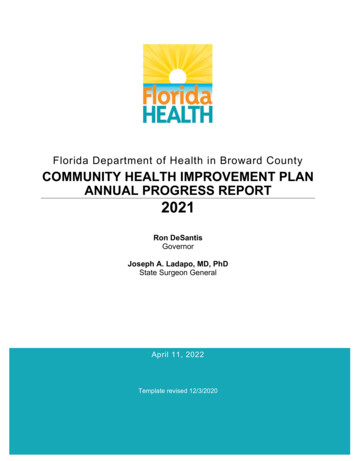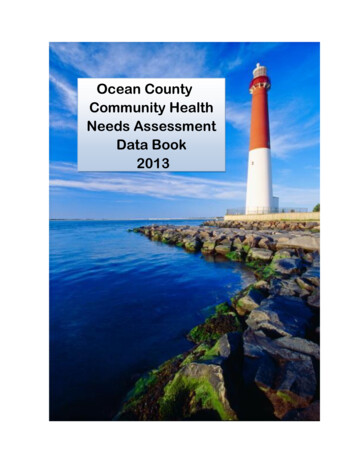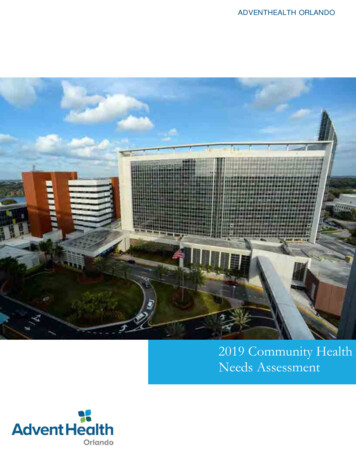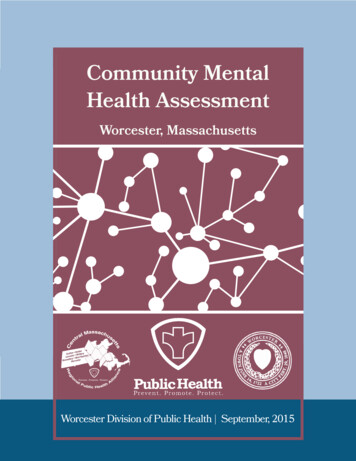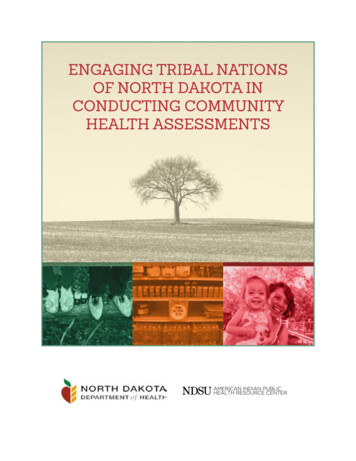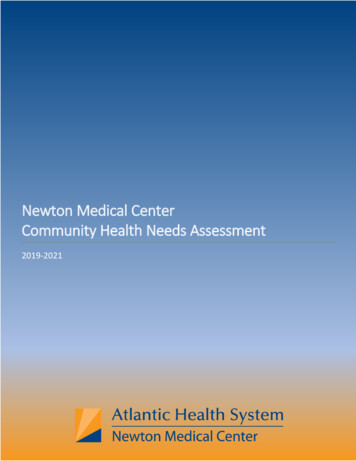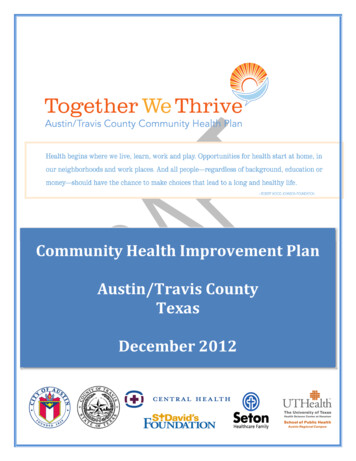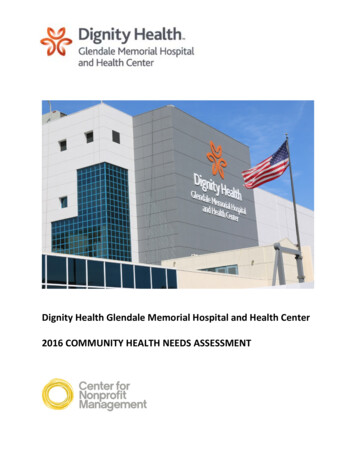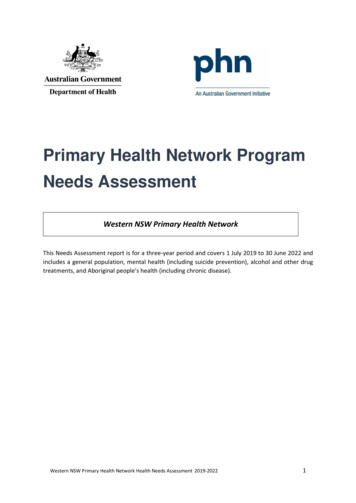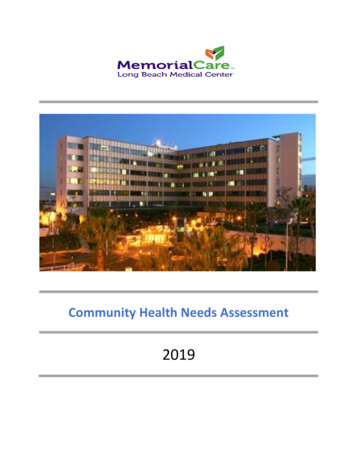
Transcription
Community Health Needs Assessment2019
Table of ContentsExecutive Summary . 3Report Adoption, Availability and Comments . 5Introduction . 6MemorialCare . 6Long Beach Medical Center . 6Purpose . 6Service Area . 7Collaborative Process . 8Consultants . 8Methodology. 9Data Collection . 9Secondary Data Sources and Analysis . 9Zip Codes and Zip Code Tabulation Areas . 9Disparities Analysis. 9Data Considerations . 10Primary Data Methods and Analysis . 10Focus Groups. 10Key Informant Interviews. 12Public Comment . 13Identification and Prioritization of Significant Health Needs . 14Significant Health Needs. 14Prioritization Process . 14Data Synthesis. 16Resources to Address Significant Health Needs . 17Review of Progress . 17Demographics . 18Population. 18Age . 18Race/Ethnicity . 19Language . 20Disability Status. 21Social Determinants of Health . 23Life Expectancy. 23SocioNeeds Index . 24Income and Poverty . 26Housing . 32Homelessness . 33Education . 36Public Safety. 37Environmental Pollution . 40Access to Health Care . 42Health Insurance Coverage . 42Regular Source of Care . 43Delayed or Forgone Care . 441 Long Beach Medical Center — CHNA
Oral Health/Dental Care . 47Acute and Chronic Diseases . 51Heart Disease . 51Diabetes. 52Asthma . 53Cancer. 54Sexually Transmitted Infections . 57HIV. 59Exercise, Nutrition and Weight . 62Overweight and Obesity . 62Exercise and Nutrition . 63Mental Health and Mental Disorders . 66Suicide . 67Leading Causes of Death. 70Age-Adjusted Mortality Rates . 70Leading Causes of Death and Premature Death . 70Pregnancy and Birth Outcomes. 75Infant Death Rate . 75Teen Births . 75Low-Birth Weight . 76Prenatal Care . 76Breastfeeding . 77Preventive Practices . 78Flu and Pneumonia Vaccines. 78Senior Falls and Injuries from Falls . 78Mammograms . 78Pap Smears . 78Substance Use and Misuse . 80Cigarette Smoking . 80Alcohol . 80Drug Use . 81Appendix 1. Data Sources . 84Appendix 2. Community Stakeholders . 86Appendix 3. Resources to Address Community Needs . 88Appendix 4. Report of Progress. 902 Long Beach Medical Center — CHNA
Executive SummaryMemorialCare Long Beach Medical Center (LBMC) is a 462-bed, regional medical center. TheMedical Center is located on a 54-acre campus in Long Beach, California that it shares withMiller Children’s & Women’s Hospital Long Beach.The purpose of this Community Health Needs Assessment (CHNA) is to identify and prioritizesignificant health needs of the community served by LBMC. The priorities identified in thisreport help to guide the hospital’s community health improvement programs and communitybenefit activities, as well as its collaborative efforts with organizations that share a mission toimprove health. This CHNA Report meets requirements of the Patient Protection and AffordableCare Act and California Senate Bill 697 that require tax-exempt hospitals to conduct a CHNA atleast once every three years.The Long Beach CollaborativeLong Beach Medical Center participated in a collaborative process for the Community HealthNeeds Assessment as part of the LB CHNA Collaborative, which included MemorialCare MillerChildren’s and Women’s Hospital Long Beach, Dignity Health St. Mary’s Medical Center, KaiserPermanente South Bay Medical Center, Long Beach Department of Health and Human Services,and The Children’s Clinic, Serving Children and Their Families. Given that these partners sharean overlapping service area, a collaborative effort reduced redundancies and increased datacollection efficiency.Service AreaLong Beach Medical Center is located at 2801 Atlantic Avenue, Long Beach, CA 90806. Theservice area includes 23 ZIP Codes, representing 12 cities in Los Angeles County and OrangeCounty. The service area also includes parts of Los Angeles County Service Planning Area (SPA)6, SPA 7, and SPA 8, as well as all census tracts located within these 23 ZIP Codes. The hospitalservice area was determined from the ZIP Codes that reflect a majority of patient admissions.Assessment Process and MethodsSecondary and primary data were collected to complete the CHNA. Secondary data werecollected from a variety of local, county and state sources. The analysis of secondary datayielded a preliminary list of significant health needs, which then informed primary datacollection.Primary data were obtained through 6 focus groups that engaged 91 community residents, andinterviews with 20 key community stakeholders, public health, and service providers, membersof medically underserved, low-income, and minority populations in the community, and3 Long Beach Medical Center — CHNA
individuals or organizations serving or representing the interests of such populations. Theprimary data collection process was designed to validate secondary data findings, identifyadditional community issues, solicit information on disparities among subpopulations, ascertaincommunity assets potentially available to address needs and discover gaps in resources.Summary of FindingsThe CHNA findings resulted from the analysis of secondary data and primary data from keyinformant interviews and focus groups. As a result of this analysis, the following significanthealth needs were identified:Significant Health Needs Access to Health Care Chronic Diseases Economic Insecurity Environment Exercise, Nutrition and Weight Food Insecurity Housing and Homelessness Mental Health Oral Health/Dental Care Pregnancy and Birth Outcomes Preventive Practices Public Safety Sexually Transmitted Infections Substance Use and MisusePrioritizationTo prioritize the significant health needs, an online prioritization survey obtained feedback fromthe community interviewees. The prioritization of health needs resulted in housing andhomelessness, mental health and economic insecurity as the top three needs.1. Housing and homelessness2. Mental health3. Economic insecurity4. Public safety5. Access to health care6. Chronic diseases7. Exercise, nutrition and weight8. Food insecurity9. Environment10. Substance use and misuse11. Pregnancy and birth outcomes12. Preventive practices13. Sexually transmitted infections14. Oral health/dental careFocus group participants were also asked to identify the most important significant healthneeds. The top five priorities were calculated by tallying all focus group participant votes andselecting the five significant health needs with the highest scores. The top prioritieswere:1. Access to health care2. Mental health and mental health conditions4 Long Beach Medical Center — CHNA
3. Housing and homelessness4. Public safety5. Chronic diseasesReport Adoption, Availability and CommentsThis CHNA report was adopted by the Long Beach Medical Center Board of Directors in June2019.This report is widely available to the public on the hospital’s web y-benefit. Written comments on this reportcan be submitted to communitybenefit@memorialcare.org.5 Long Beach Medical Center — CHNA
IntroductionMemorialCareMemorialCare is a nonprofit integrated health care delivery system that includes Long BeachMedical Center, Miller Children's & Women's Hospital Long Beach, Orange Coast MedicalCenter, and Saddleback Medical Center; award-winning medical groups – MemorialCareMedical Group and Greater Newport Physicians; Seaside Health Plan; and convenientoutpatient health centers, imaging centers, surgical centers and dialysis centers throughoutOrange and Los Angeles Counties.Long Beach Medical CenterLong Beach Medical Center (LBMC) is a 462-bed, state-of-the-art regional medical center.Established as Seaside Hospital in 1907, it became known as Long Beach Memorial Hospital in1958. The Medical Center is located on a 54-acre campus that it shares with Miller Children’s &Women’s Hospital Long Beach. These hospitals function under the same tax identificationnumber but are separately licensed hospitals. The hospital mission is to improve the health andwell-being of individuals, families and our communities.As a regional medical center, Long Beach Medical Center provides health care through manyspecialties and services, including the Certified Comprehensive Stroke Center, Long Beach Adultand Pediatric Sleep Center, MemorialCare Breast Center, MemorialCare Heart & VascularInstitute, MemorialCare Imaging Center, MemorialCare Joint Replacement Center,MemorialCare Rehabilitation Institute, MemorialCare Todd Cancer Institute, Spine HealthCenter and Trauma Center. For a complete list of LBMC’s services r.PurposeLBMC has undertaken a CHNA as requiredby state and federal law. California’s SenateBill 697 and the Patient Protection andAffordable Care Act through IRS section501(r)(3) regulations direct tax-exempthospitals to conduct a Community HealthNeeds Assessment and develop anImplementation Strategy every three years.Analyze Data& CommunityInputEvaluateActions TakenImplement6 Long Beach Medical Center — CHNA3 YearCyclePrioritizeHealth NeedsCHNA Report
Service AreaLong Beach Medical Center is located at 2801 Atlantic Avenue, Long Beach, CA 90806. Theservice area includes 23 ZIP Codes, representing 9 cities in Los Angeles County and 3 cities inOrange County. The service area also includes parts of Los Angeles County Service PlanningArea (SPA) 6, SPA 7, and SPA 8, as well as all census tracts located within these 23 ZIP Codes.The hospital service area was determined from the ZIP Codes that reflect a majority of patientadmissions.LBMC Service woodLong BeachLos AlamitosNorwalkParamountSeal BeachSignal HillZIP Code90706907459070390220, 902219063090712, 9071390802, 90803 90804, 90805, 90806,90807, 90808, 90810, 90813, 908149072090650907239074090755Map of the Service Area7 Long Beach Medical Center — CHNAService Planning Area/CountySPA 7/Los AngelesSPA 8/Los AngelesSPA 7/Los AngelesSPA 6/Los AngelesOrange CountySPA 7/Los AngelesSPA 8/Los AngelesOrange CountySPA 7/Los AngelesSPA 6/Los AngelesOrange CountySPA 8/Los Angeles
Collaborative ProcessLong Beach Medical Center participated in a collaborative process for the Community HealthNeeds Assessment as part of the LB CHNA Collaborative, which included MemorialCare MillerChildren’s and Women’s Hospital Long Beach, Dignity Health St. Mary’s Medical Center, KaiserPermanente South Bay Medical Center, Long Beach Department of Health and Human Services,and The Children’s Clinic, Serving Children and Their Families. Given that these partners sharean overlapping service area, a collaborative effort reduced redundancies and increased datacollection efficiency.ConsultantsConduent Healthy Communities Institute (HCI) conducted the 2019 Community Health NeedsAssessment. HCI works with clients across the nation to drive community health outcomes byassessing needs, developing focused strategies, identifying appropriate intervention programs,establishing monitoring systems, and implementing performance evaluation processes. To learnmore about Conduent Healthy Communities Institute, please Long Beach Forward conducted the focus groups. The mission of Long Beach Forward is tocreate a healthy Long Beach with low-income communities of color by building communityknowledge, leadership and power. The focus groups were conducted by Cynthia Howell andSevly Snguon, with support from Ariel Halstead, MPH. Data analysis, tables, and figure offrequency codes were provided by Sevly Snguon. The focus group report was written by CynthiaHowell, MPH, Christine Petit, PhD, and Sevly Snguon, MPH. https://www.lbforward.org/8 Long Beach Medical Center — CHNA
MethodologyData CollectionPrimary and secondary data were used in this assessment. Primary data were collected directlyfrom members of the community and were obtained through focus groups and key informantinterviews. Secondary data are health indicator data that have been collected by public sourcessuch as the Census Bureau and health departments. Data findings were organized by healthtopics and then synthesized for an overview of the health needs in hospital’s service area.Secondary Data Sources and AnalysisSecondary data were collected and analyzed from HCI’s community indicator database. Thisdatabase, maintained by researchers and analysts at HCI, includes over 100 communityindicators from state and national data sources. HCI evaluated the data sources based on thefollowing three criteria: the source has a validated methodology for data collection andanalysis; the source has scheduled, regular publication of findings; and the source has datavalues for small geographic areas or populations. A list of data sources can be found inAppendix 1.Zip Codes and Zip Code Tabulation AreasThis report presents ZIP Code and ZIP Code Tabulation Area (ZCTA) data. ZCTAs arerepresentative of geographic locations of populated areas. In most cases, the ZCTA will be thesame as its ZIP Code. ZCTAs will not necessarily exist for ZIP Code areas with only businesses,single or multiple addresses, or for large unpopulated areas. Demographics for this report aresourced from the United States Census Bureau, which presents ZCTA estimates. Tables andfigures in the Demographics section of this report reference ZIP Codes in the titles (for purposesof familiarity) but show values of ZCTAs. Data from other sources are represented by ZIP Codesand are labeled as such.Disparities AnalysisWhen a given indicator had available subgroup data (e.g. race/ethnicity, age or gender) andvalues for these subgroups included confidence intervals, significant differences between thesubgroups’ value and the overall value were determined. A significant difference is defined astwo values with non-overlapping confidence intervals. Only significant differences in which thevalue for a subgroup is worse than the overall value are identified. Confidence intervals are notavailable for all indicators. In these cases, there was not enough data to determine if two valueswere significantly different from each other.9Long Beach Medical Center
Data ConsiderationsSeveral limitations of data should be considered when reviewing the findings presented in thisreport. Although the topics by which data are organized cover a wide range of health andhealth-related areas, data availability varies by health topic. Some topics contain a robust set ofsecondary data indicators, while others may have a limited number of indicators or limitedsubpopulations covered by those specific indicators.Some of the secondary data indicators included in the findings are collected by survey, andthough specific methods are used to best represent the population at large, these measures aresubject to instability, especially for smaller populations. The analysis of subpopulationdisparities is also limited by data availability, where indicator data vary based on the populationgroups and service areas being analyzed.Primary Data Methods and AnalysisCommunity input was collected to expand upon the information gathered from the secondarydata. Primary data used in this assessment consisted of focus groups and key informantinterviews.Focus GroupsLong Beach Forward (LBF), a community-based organization that focuses on producing ahealthy Long Beach, was selected by the Collaborative to conduct focus groups. TheCollaborative provided guidance to LBF on the populations to engage, focus-group questions,and significant health needs for prioritization. LBF designed the focus-group protocol, whichincluded a consent form for participation, a 23-question survey, and focus-group facilitationguide. The Collaborative provided feedback on the protocol, which was incorporated by LBF.Focus groups were conducted through six Long Beach-based organizations or programs,including The LGBTQ Center of Long Beach, Long Beach Alliance for Children with Asthma, LongBeach Department of Health and Human Services’ Black Infant Health Program, Project ReturnPeer Support Network at Century Villages at Cabrillo, Rose Park Neighborhood Association, andUnited Cambodian Community. LBF selected organizational/program partners that would beable to reach two or more vulnerable populations as defined by the Collaborative and were asrepresentative of the vulnerable populations as possible within the scope of the project.Each organization secured the participation of 12-20 participants using the most effectivemethod for their target audiences. Two organizations distributed a flyer, while others usedword of mouth, targeted outreach and email invitations. Partners advertised a 20 cashincentive for participants as well as food and interpretation as needed. Four of the focus groupswere conducted in English, one in Khmer, and one in Spanish.10 Long Beach Medical Center
Qualitative analysis was performed using a vertical inductive approach, where all responses andcomments by participants were given at least one descriptive code. Quantitative analysis wasconducted to describe the key characteristics of the focus group participants.A total of 91 participants participated in the 6 focus groups. The socioeconomic anddemographic characteristics of the focus group participants are outlined below.Descriptive Characteristics of Focus Group Participants (N 91)Socioeconomic and Demographic CharacteristicsN (%)Age18-24 years8 (9%)25-34 years12 (13%)35-44 years17 (19%)45-54 years12 (13%)55-64 years17 (19%)65-74 years21 (23%)75 years 4 (4%)GenderMan (includes small sample of trans-identified men)29 (31%)Woman60 (66%)Education StatusLess than high school19 (23%)High school or GED equivalent17 (19%)Some college (no Associates)23 (26%)Associate’s or Bachelor's Degree22 (24%)Master’s Degree or Higher9 (10%)Housing StatusRenter51 (56%)Homeowner14 (15%)Currently experiencing homelessnessLiving with family or friends3 (3%)21 (23%)Other2 (2%)RaceAsian23 (25%)African-American/Black12 (13%)White23 (25%)Hispanic/Latino26 (29%)11 Long Beach Medical Center
Multiracial7 (8%)EthnicityCambodian21 (23%)Hispanic/Latino26 (29%)Sexual OrientationStraight62 (68%)Gay9 (10%)Lesbian, Queer, Bisexual12 (13%)IncomeUnder 10,00030 (33%) 10,000 to 19,99917 (19%) 20,000 to 39,99911 (12%) 40,000 to 69,9998 (9%) 70,000 Don't know14 (15%)6 (7%)Key Informant InterviewsCommunity input was also collected through key informant interviews. Twenty key informantinterviews (KIIs) were conducted by phone from January through March 2019. Intervieweeswho were asked to participate were recognized as having expertise in public health, specialknowledge of community health needs and/or represented the broad interest of thecommunities served by the hospital, and/or could speak to the needs of medically underservedor vulnerable populations.The identified stakeholders were invited by email to participate in a phone interview.Appointments for the interviews were made on dates and times convenient to thestakeholders. At the beginning of each interview, the purpose of the interview in the context ofthe needs assessment was explained, the stakeholders were assured their responses wouldremain confidential, and consent to proceed was given.Interviews were transcribed and analyzed using the qualitative analytic tool called Dedoose 1.Interview excerpts were coded by relevant topic areas and key health themes. Multipleapproaches were used to assess the relative importance of the needs discussed in theseinterviews. These approaches included: The frequency by which a health topic was discussed across all interviews1Dedoose Version 8.0.35, web a
To prioritize the significant health needs, an online prioritization survey obtained feedback from the community interviewees. The prioritization of health needs resulted in housing and homelessness, mental health and economic insecurity as the top three needs. 1. Housing and homelessness 2. Mental health 3. Economic insecurity 4. Public safety 5.
